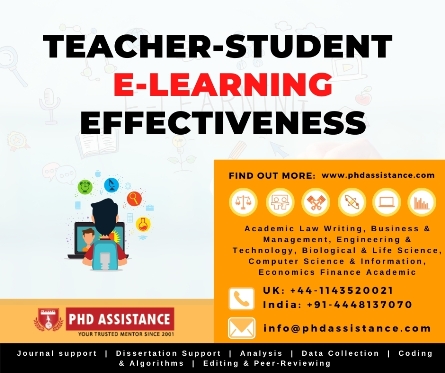Teacher- Student E- learning Effectiveness
Information Technology
In the present era, Information and Communication Technology (ICT) has brought a plethora of advances and breakthroughs to a wide range of businesses. As a result of ICT, several educational institutions have implemented innovative modifications. Many academic and non-academic institutions used information systems to manage their records. On the other hand, few institutions used ICT infrastructures for human resource management, internal and external communication purpose etc. Institutions are required to keep up with the demands, desires, and expectations of students and teachers in today’s higher education system, which is in a constant state of flux [1]. As a result, information technology and E-learning systems acts as critical components in universities’ operations, with these institutions increasingly investing in online systems [2]. Thus, in the technology era, teaching and learning are two major features of educational institutions that are influenced by ICT innovation.

E-learning
At the same time, the present coronavirus pandemic has altered the process of teaching-learning process in education institutions and has also changed teacher-student interactions. Universities were forced to carry out their activities with students and teachers completely online as a result of the epidemic [3]. While internet-based learning is generally thought of as an alternative to traditional learning, it became a vital component in keeping schools and colleges open during the Coronavirus outbreak [4]. The emergence of e-learning platforms has alleviated a great deal of the stress that comes with teaching and learning at various universities. It is incredibly simple for teachers to exchange and distribute instructional resources to their students. Mohammed et al., [5] E-learning has the potential to expand access to training & education, as well as the quality of teaching and learning. It also highlights the necessity for higher education institutions to maintain a competitive edge in this rapidly changing market for students and teachers. As a result, IT is now being fully utilized to improve the teaching and learning process while also offering educational programs to a larger number of students at a reduced cost [6]. E- Learning has potential benefits for teachers and students as stated below
- Time and location flexibility
- Expands communication between students
- Expands communication between student and teachers
- Allows for a variety of learning styles and methodologies
- Course materials availability and accessibility
- It moderates the faculty workload and provides confidence and composure to learners

Figure 1: E-learning effectiveness
Conclusion
Most decision-makers associate e-learning with innovative learning approaches that are more cost-effective than traditional learning tactics. This allows students to personalize their learning experiences while also allowing teachers to better arrange their teaching approaches. This has had a significant impact on how information is handled and maintained in academic settings. Numerous learning initiatives, as well as electronic resources in several learning facilities, have been designed to aid in the development of students [7]. As e-learning has grown in popularity in academic institutions and provide potential benefits to students and teachers, it has become more important to investigate the impact technology has on teaching techniques and student performance.
References
[1] H. Fischer, L. Heise, M. Heinz, K. Moebius, en T. Koehler, “E-Learning Trends and Hypes in Academic Teaching. Methodology and Findings of a Trend Study.”, Int. Assoc. Dev. Inf. Soc., 2014, [Online]. Available at: https://eric.ed.gov/?id=ED557279.
[2] A. Popovici en C. Mironov, “Students’ Perception on Using eLearning Technologies”, Procedia – Soc. Behav. Sci., vol 180, bll 1514–1519, Mei 2015, doi: 10.1016/j.sbspro.2015.02.300.
[3] A. E. E. Sobaih, A. M. Hasanein, en A. E. Abu Elnasr, “Responses to COVID-19 in higher education: Social media usage for sustaining formal academic communication in developing countries”, Sustainability, vol 12, no 16, bl 6520, 2020, [Online]. Available at: https://www.mdpi.com/2071-1050/12/16/6520.
[4] W. Ali, “Online and remote learning in higher education institutes: A necessity in light of COVID-19 pandemic.”, High. Educ. Stud., vol 10, no 3, bll 16–25, 2020, [Online]. Available at: https://eric.ed.gov/?id=EJ1259642.
[5] A. Mohammed, S. Kumar, B. M. Saleh, en A. Shuaibu, “E-learning: A tool for enhancing teaching and learning in educational institutes”, Int. J. Comput. Sci. Inf. Technol., vol 8, no 2, bll 217–221, 2017, [Online]. Available at: https://www.researchgate.net/profile/Abubakar_Mohammed18/publication/321304469_E-Learning_A_Tool_for_Enhancing_Teaching_and_Learning_in_Educational_Institutes/links/5a1b35de4585155c26adea63/E-Learning-A-Tool-for-Enhancing-Teaching-and-Learning-in-Educational-Institutes.pdf.
[6] J. @ E. Luaran, N. N. Samsuri, F. A. Nadzri, en K. B. M. Rom, “A Study on the Student’s Perspective on the Effectiveness of Using e-learning”, Procedia – Soc. Behav. Sci., vol 123, bll 139–144, Mrt 2014, doi: 10.1016/j.sbspro.2014.01.1407.
[7] A. Alenezi, “The Role of e-Learning Materials in Enhancing Teaching and Learning Behaviors”, Int. J. Inf. Educ. Technol., vol 10, no 1, bll 48–56, 2020, doi: 10.18178/ijiet.2020.10.1.1338.
 Previous Post
Previous Post Next Post
Next Post
